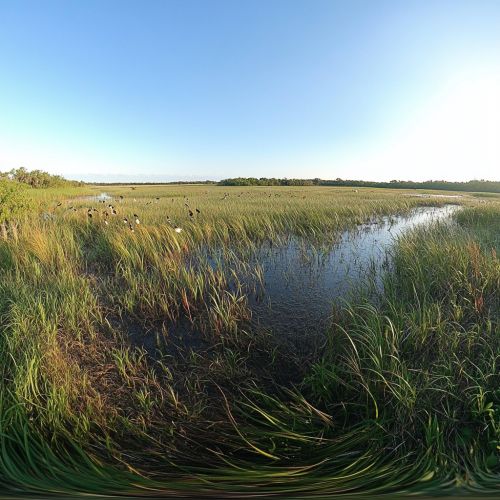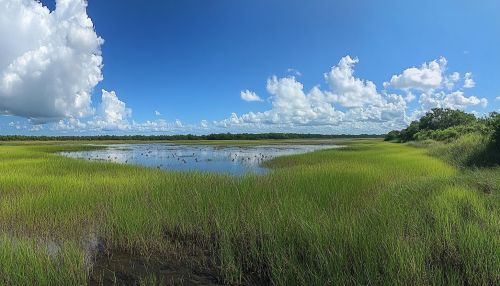Merritt Island National Wildlife Refuge: Difference between revisions
(Created page with "== Introduction == The Merritt Island National Wildlife Refuge is a protected area located on the east coast of Florida, USA. It was established in 1963 as part of the development of the John F. Kennedy Space Center. The refuge encompasses over 140,000 acres of diverse habitats, including saltwater marshes, freshwater impoundments, hardwood hammocks, pine flatwoods, and coastal dunes. This unique blend of ecosystems supports a wide variety of flora and fauna, making it...") |
No edit summary |
||
| Line 33: | Line 33: | ||
The coastal dunes along the Atlantic shoreline are dynamic environments shaped by wind and waves. These dunes are stabilized by vegetation such as [[Uniola paniculata|sea oats]] and [[Ipomoea pes-caprae|beach morning glory]]. The dunes provide nesting sites for [[Caretta caretta|loggerhead sea turtles]] and habitat for shorebirds like the [[Charadrius melodus|piping plover]]. | The coastal dunes along the Atlantic shoreline are dynamic environments shaped by wind and waves. These dunes are stabilized by vegetation such as [[Uniola paniculata|sea oats]] and [[Ipomoea pes-caprae|beach morning glory]]. The dunes provide nesting sites for [[Caretta caretta|loggerhead sea turtles]] and habitat for shorebirds like the [[Charadrius melodus|piping plover]]. | ||
[[Image:Detail-104431.jpg|thumb|center|A panoramic view of a saltwater marsh at Merritt Island National Wildlife Refuge, with smooth cordgrass and a variety of bird species visible.|class=only_on_mobile]] | |||
[[Image:Detail-104432.jpg|thumb|center|A panoramic view of a saltwater marsh at Merritt Island National Wildlife Refuge, with smooth cordgrass and a variety of bird species visible.|class=only_on_desktop]] | |||
== Flora and Fauna == | == Flora and Fauna == | ||
Latest revision as of 18:36, 18 November 2024
Introduction
The Merritt Island National Wildlife Refuge is a protected area located on the east coast of Florida, USA. It was established in 1963 as part of the development of the John F. Kennedy Space Center. The refuge encompasses over 140,000 acres of diverse habitats, including saltwater marshes, freshwater impoundments, hardwood hammocks, pine flatwoods, and coastal dunes. This unique blend of ecosystems supports a wide variety of flora and fauna, making it a critical site for biodiversity conservation and a popular destination for wildlife enthusiasts.
Geography and Climate
Merritt Island National Wildlife Refuge is situated on Merritt Island, which is part of the larger barrier island complex along Florida's Atlantic coast. The refuge is bordered by the Indian River Lagoon to the west and the Atlantic Ocean to the east. The topography of the refuge is relatively flat, with elevations ranging from sea level to approximately 10 feet above sea level.
The climate of the refuge is classified as humid subtropical, characterized by hot, humid summers and mild, dry winters. The average annual temperature is around 72°F (22°C), with rainfall averaging about 50 inches per year. The refuge is subject to tropical storms and hurricanes, which can significantly impact the landscape and habitats.
Habitats and Ecosystems
Merritt Island National Wildlife Refuge is home to a mosaic of habitats that support a rich diversity of plant and animal species. The primary habitats include:
Saltwater Marshes
Saltwater marshes are prevalent throughout the refuge, particularly along the edges of the Indian River Lagoon. These marshes are dominated by smooth cordgrass and black needlerush, providing essential habitat for a variety of bird species, including the clapper rail and the great blue heron.
Freshwater Impoundments
The refuge contains several freshwater impoundments, which are managed to provide habitat for waterfowl and other aquatic species. These impoundments are critical for the survival of migratory birds such as the mallard and the American wigeon. The impoundments also support populations of American alligators and various species of fish.
Hardwood Hammocks
Hardwood hammocks are dense stands of broadleaf trees, including live oak, cabbage palm, and red maple. These areas provide important habitat for a variety of wildlife, including the white-tailed deer and the raccoon. The understory is rich with shrubs and ferns, offering cover and food for smaller mammals and birds.
Pine Flatwoods
Pine flatwoods are characterized by an open canopy of slash pine and a diverse understory of shrubs and grasses. These habitats are maintained by periodic fire, which helps to control the growth of hardwoods and promote the regeneration of fire-adapted species. Pine flatwoods are home to species such as the gopher tortoise and the eastern indigo snake.
Coastal Dunes
The coastal dunes along the Atlantic shoreline are dynamic environments shaped by wind and waves. These dunes are stabilized by vegetation such as sea oats and beach morning glory. The dunes provide nesting sites for loggerhead sea turtles and habitat for shorebirds like the piping plover.


Flora and Fauna
The Merritt Island National Wildlife Refuge is renowned for its biological diversity, supporting over 1,500 species of plants and animals. The refuge is particularly significant for its bird populations, with more than 330 species recorded.
Avian Species
The refuge is a critical stopover for migratory birds along the Atlantic Flyway. Notable species include the brown pelican, the osprey, and the little blue heron. The refuge also provides habitat for several endangered and threatened species, such as the wood stork and the bald eagle.
Mammals
Mammalian species in the refuge include the Florida black bear, the marsh rabbit, and the round-tailed muskrat. The refuge is also home to the Florida manatee, which can be found in the warm waters of the Indian River Lagoon.
Reptiles and Amphibians
Reptiles and amphibians are abundant in the refuge, with species such as the American alligator, the Florida red-bellied cooter, and the green tree frog. The refuge also supports populations of the gopher tortoise, a keystone species in the pine flatwoods ecosystem.
Invertebrates
Invertebrates play a crucial role in the refuge's ecosystems, with numerous species of insects, crustaceans, and mollusks present. The blue crab and the marsh periwinkle are common in the saltwater marshes, while the monarch butterfly can be seen in the hardwood hammocks and open fields.
Conservation and Management
The management of Merritt Island National Wildlife Refuge focuses on preserving its diverse habitats and species while accommodating public use and space exploration activities. Key management practices include:
Habitat Restoration
Efforts are made to restore and maintain the natural habitats within the refuge. This includes controlling invasive species, such as the melaleuca tree, and reintroducing native vegetation. Fire management is also employed to maintain the health of fire-dependent ecosystems like pine flatwoods.
Species Protection
The refuge implements measures to protect endangered and threatened species, such as the loggerhead sea turtle and the piping plover. Nesting sites are monitored, and conservation programs are in place to enhance breeding success and reduce human disturbance.
Public Use and Education
Merritt Island National Wildlife Refuge offers a range of recreational opportunities, including birdwatching, fishing, and hiking. The refuge also provides educational programs and interpretive exhibits to raise awareness about its natural resources and conservation efforts.
Challenges and Threats
The refuge faces several challenges and threats, including habitat loss, climate change, and human disturbance. Rising sea levels and increased storm frequency pose significant risks to coastal habitats. Additionally, the proximity of the Kennedy Space Center requires careful coordination to balance conservation with space exploration activities.
